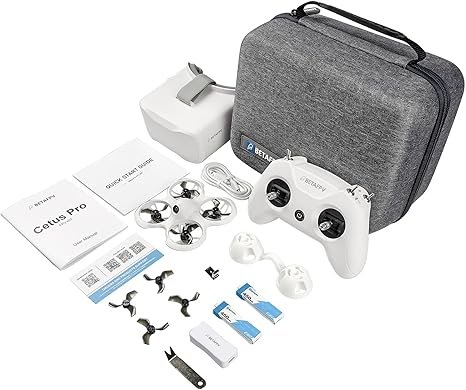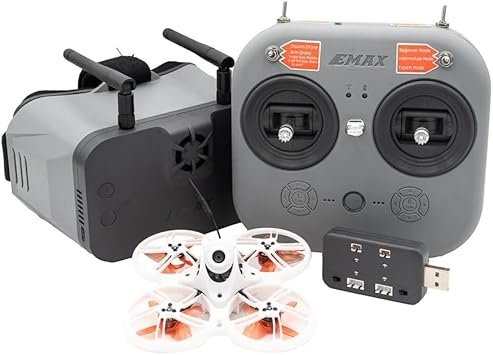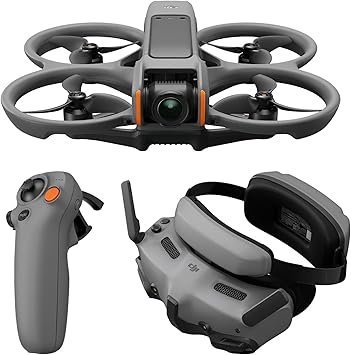The world of FPV (First-Person View) drones is an exhilarating frontier, offering an unparalleled sense of immersion as you soar through the skies from the drone’s perspective. Unlike traditional camera drones, FPV flying is all about agility, speed, and a visceral connection to the flight. It’s a thrilling hobby, but for newcomers, the sheer variety and technical complexity can seem daunting.
Fear not, aspiring FPV pilots! Getting started is easier than ever, thanks to a new generation of beginner-friendly drones and ready-to-fly (RTF) kits that provide everything you need to dive in. These models prioritize ease of use, durability, and a forgiving learning curve, ensuring your initial flights are more fun and less frustrating. We’ve curated a list of the 3 best beginner-friendly FPV drones that are perfect for your first foray into this exciting world. For a broader look at various drone categories and what to consider when buying, check out our comprehensive best drones: top picks and reviews guide.
1. BETAFPV Cetus Pro FPV Drone Kit with 3 Flight Modes Altitude Hold Emergency Landing Self Protection Turtle Mode with Radio Transmitter Goggles for FPV Beginners Player-to-Pilot

The BETAFPV Cetus Pro Kit stands out as the ultimate entry point for absolute FPV beginners, offering an incredibly comprehensive and forgiving package. It includes everything you need right out of the box: the drone, a radio transmitter, and FPV goggles, eliminating the guesswork of compatibility. What truly sets the Cetus Pro apart for novices are its multiple flight modes, including a crucial altitude hold feature, which simplifies control significantly. This allows pilots to focus on directional control without worrying about throttle management, making initial flights remarkably stable and confidence-inspiring. At an approximate price of $247.99, it represents fantastic value for an all-in-one FPV learning system that genuinely helps you go from ‘player’ to ‘pilot’.
Pros
- Complete RTF Kit: Comes with drone, remote, and goggles – truly ready to fly.
- Beginner-Friendly Flight Modes: Altitude hold mode makes learning much easier.
- Durable Design: Built-in propeller guards and self-protection features reduce damage from crashes.
- Turtle Mode: Allows the drone to flip itself over after a crash, saving you walking time.
- Affordable Entry Point: Excellent value for a full FPV experience.
Cons
- Limited Power/Speed: Not designed for aggressive freestyle or racing.
- Analog Video Feed: Lower resolution compared to digital FPV systems.
2. Tinyhawk 3 PLUS+ RTF Kit Ready To Fly ELRS Analog FPV Drone Mini Racing Quadcopter Durable Frame with Controller and Goggles for Beginners

The Tinyhawk 3 PLUS+ RTF Kit is another excellent choice for beginners who are serious about learning the nuances of FPV, especially if your goal is to eventually transition to more advanced freestyle or racing. Like the Cetus Pro, it’s a complete ready-to-fly package, which is a huge advantage for newcomers. What sets the Tinyhawk 3 PLUS+ apart is its focus on a more ‘true’ FPV experience from the outset, leaning more towards manual flight characteristics while still being incredibly forgiving due to its lightweight and durable frame. This drone is perfect for indoor flying or small outdoor spaces, allowing you to practice without significant risk of damage. At around $299.99, it offers a robust platform for skill progression.
Pros
- Excellent Learning Platform: Ideal for mastering manual (Acro) flight modes.
- Highly Durable Frame: Built to withstand crashes, essential for learning.
- Compact Size: Perfect for indoor flying and small outdoor areas.
- ELRS Radio System: Provides robust and long-range control link for future upgrades.
- Complete RTF Kit: Everything included to start flying immediately.
Cons
- Steeper Learning Curve: Less automated assistance compared to the Cetus Pro for absolute beginners.
- Analog Video: Lower resolution FPV feed compared to digital systems.
- Battery Life: Short flight times typical of micro FPV drones.
3. DJI Avata 2 Fly More Combo (1 Battery), FPV Drones with Camera for Adults 4K, Immersive Experience, Built-in Propeller Guard, Easy Flip/Roll, FAA Remote ID Compliant, POV Content Drone, Black

The DJI Avata 2 represents the pinnacle of premium, user-friendly FPV flying, especially for those who want a high-quality, cinematic FPV experience without the steep learning curve of traditional FPV builds. While its approximate price of $999.00 places it at a much higher price point than the other two contenders, its ease of use and advanced features make it remarkably „beginner-friendly” for a premium FPV drone. The built-in propeller guards offer significant crash resistance, and its stable flight characteristics, especially when paired with the intuitive Motion Controller (often included in Fly More Combos), allow new pilots to enjoy immersive flight almost immediately. It records stunning 4K video, making it ideal for creating dynamic POV content right out of the gate.
Pros
- Exceptional Ease of Use: DJI’s intuitive controls and stability make FPV accessible.
- Stunning 4K Video Quality: Delivers cinematic FPV footage directly from the drone.
- Integrated Propeller Guards: Highly durable and safer for flying indoors or near obstacles.
- Advanced Safety Features: Includes emergency braking and RTH (Return-to-Home).
- Immersive Digital FPV Experience: High-resolution, low-latency video feed through DJI Goggles 3.
Cons
- High Price Point: Significantly more expensive than traditional beginner FPV kits.
- Less Customizable: Not designed for tinkering or extensive modifications like other FPV drones.
- Not for True Acro Training: While it has a manual mode, it’s less suited for learning raw FPV freestyle skills than dedicated racing drones.
Key Factors for Choosing Your First FPV Drone
Selecting your first FPV drone can feel overwhelming, but focusing on a few key areas will help you make the right choice for your needs and budget. Remember, the goal for a beginner is to maximize fun and learning while minimizing frustration and expensive repairs.
Ready-To-Fly (RTF) Kits vs. Build Your Own
For beginners, Ready-To-Fly (RTF) kits are highly recommended. These packages include the drone, a radio transmitter (controller), and FPV goggles, ensuring all components are compatible and pre-bound, so you can literally fly right out of the box. While building your own FPV drone is a rewarding aspect of the hobby, it requires significant technical knowledge and can be a frustrating experience for someone just starting out. RTF kits remove that barrier, letting you focus purely on flying.
Flight Modes and Assistance
Look for drones that offer multiple flight modes, especially those with beginner-friendly options like altitude hold or stabilized modes. Altitude hold automatically maintains the drone’s height, freeing you up to focus on directional control. Stabilized modes (often called Angle or Horizon mode) self-level the drone when you release the sticks, preventing it from flipping unexpectedly. As you gain confidence, you can then transition to more advanced modes like Acro (manual) mode, which gives you full control and is essential for true FPV freestyle.
Durability and Repairability
Crashes are an inevitable part of learning FPV. Therefore, choosing a drone that can withstand impacts is crucial. Look for models with durable frames, propeller guards (especially for indoor flying), and easily replaceable parts. Some drones also feature „Turtle Mode,” which allows the drone to flip itself over if it lands upside down, saving you time and effort. While the DJI Avata 2 has exceptional integrated guards, smaller whoop-style drones like the Cetus Pro and Tinyhawk are also surprisingly resilient.
Budget and Value
FPV drones range widely in price. Beginner kits typically fall within the $200-$400 range, offering excellent value for a complete setup. More premium options like the DJI Avata 2, while significantly more expensive, provide a more polished and capable experience with higher quality cameras and digital FPV feeds. Consider your budget carefully, but also think about the longevity of your purchase. An affordable RTF kit allows you to learn the ropes without a huge initial investment, and you can always upgrade later as your skills develop.
Our Final Thoughts
Diving into FPV flying is an incredibly rewarding experience, offering a unique perspective and a thrilling sense of freedom. For beginners, the key is to start with equipment that supports your learning journey, not complicates it. The BETAFPV Cetus Pro Kit stands out as the most accessible and value-packed option for those taking their very first flights, thanks to its complete package and forgiving flight modes.
If you’re ready to embrace the manual control and progression towards advanced FPV, the Tinyhawk 3 PLUS+ RTF Kit offers a durable and capable platform. And for those seeking a premium, cinematic FPV experience with unparalleled ease of use and fantastic image quality right from the start, the DJI Avata 2 is an excellent, albeit pricier, choice. Whichever drone you choose, remember to start slow, practice in a safe environment, and enjoy the ride!



